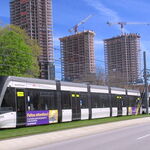Trade, innovation Canada’s transportation future: Garneau
0 32
Infrastructure
by
Lindsey Cole Nov 17, 2016
The year 2030 will look vastly different when it comes to transportation systems in Canada, with clean, green and innovative advancements at the forefront, federal Minister of Transport Marc Garneau predicted at the Canadian Council for Public-Private Partnerships (CCPPP) conference in Toronto.
Marc Garneau, Canada’s transport minister, delivered the opening keynote address at this year’s CCPPP conference. Garneau presented the federal government’s vision for its Transportation 2030 strategy which is focused on a green and innovative transportation future. - Photo: WARREN FREY
"This year's conference theme and its focus on the future is fitting," he explained, since the 24th annual conference is coined Innovating our Future.
"Transportation, innovation and infrastructure cannot exist in isolation. They are intertwined and interdependent. In order to realize the vision we have set forth we need to create successful P3s. We need to support innovation and invest in infrastructure that can support Canada's transportation system into the future."
Garneau envisioned a country where "there will be smart cars using smart roads and unmanned aerial vehicles in the skies."
He highlighted how the federal government, through its Transportation 2030 strategy, will work with the provinces on a "pan-Canadian" framework to reduce pollution by 30 per cent from 2005 levels by 2030. This means investing in smart grids, electricity transmission, renewable power and smart cities that will lead to cleaner transportation technology.
He said the government has already invested $62 million in electric car charging and low-emission fuelling stations.
"The transportation sector accounts for almost a quarter of all greenhouse gases in Canada and 80 per cent of these emissions come from cars and trucks, the two big elephants in the tent," he said.
"Canada's transportation system in 2030 will be increasingly electrified, supporting alternative fuels. We must focus on investing on the future of these sectors so that they are cleaner and more environmentally responsible."
When an audience question surfaced pertaining to tolls as a method to potentially pay for the infrastructure road upgrades in the future, Garneau stated it is a possibility.
"We certainly realize that if the P3 (public-private partnership) concept is going to work...it will only work if it's a good business case for the business sector," Garneau said. "We're open to that concept. It is something that will be examined."
Another key focus Garneau outlined during his address was on trade corridors and getting goods, services and people to global markets. He said the federal government is investing $10.1 billion in transportation infrastructure to help eliminate bottlenecks in order to build more "robust" trade corridors.
"We know that trade will be critical to the Canadian economy and that trade will have shifted significantly to Asia and other developing regions," he stated. "We must be able to get Canadian products, services and people to key markets. We will achieve this by creating advanced gateways and seamless logistics in intelligent infrastructure. That takes investment — investment that must be made today."
Mark Romoff, president and CEO of the CCPPP, said the focus on trade enabling infrastructure could provide more opportunities for P3 projects.
"All of a sudden you have other areas that have not historically been areas or sectors where the P3 model has been applied, but it fits it perfectly," he said.
"And so there are opportunities now, in terms of port development, whether it's out in British Columbia or other parts of the country, where I think you're going to find a pretty good mapping with the structure and methodology that the P3 brings because these are big infrastructure projects."
"The kinds of projects he was talking about are all large and complex and they'll appear in the next phase of the government's infrastructure strategy and plan, so I think there's encouraging news there for us," Romoff added.
Garneau mentioned there are several projects already underway in Canada that are improving the flow of trade, such as improvements to the port of Halifax, the Gordie Howe International Bridge project between Detroit, Mich. and Windsor, Ont. and the Champlain Bridge project in Montreal.
He also mentioned a proposal from Via Rail that the federal government is currently studying which would see more trains flowing along the Toronto-Ottawa-Montreal corridor. That could only be possible with "a dedicated rail track," he said, adding the government set aside $3.3 million in the 2016 budget to study the project's feasibility, which would likely be built using a P3 model.
"It's an exciting proposal. Having its own dedicated line will allow it to go at higher speeds. We're looking at it to see if the business case is good. We just have to do our due diligence," he said.
Nov 17, 2016






